


Capacitor - a new componentSo far, we have studied the effects of electricity flowing through wires, and have discussed resistors, coils, and metering devices. Both resistors and coils, as we have found, have a restricting effect on the flow of current. We also discussed how a coil has more resistance to AC than it does to DC. You will learn later just how important these effects are, but first we must discuss a few more electrical components. Another component which has a restricting effect on current flow, but in a different way. This component is called the CAPACITOR. 


Now, if we should reverse the action, and push the plunger down in the second tank, it would move the membrane in the opposite direction, also moving the water within the tanks in the opposite direction, but AT NO TIME would the water flow from one tank into the other tank. It would have the effect of movement from one tank to the other, without actually having done so. This is basically the same operating principle behind another of electronics most important components - the capacitor. The capacitor appears to have the effect of passing alternating current, while actually not passing anything. At the same time, it blocks the flow of direct current. Just as in the water circuit, the water flow in either given direction is blocked by the membrane, if we should push the water pressure, and hence the membrane back and forth, it would appear as if the membrane weren't there at all, except that the food coloring would not pass from one container to the other. 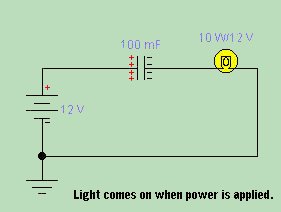
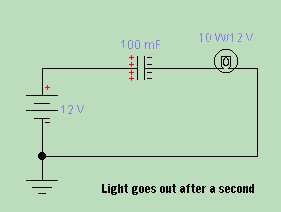
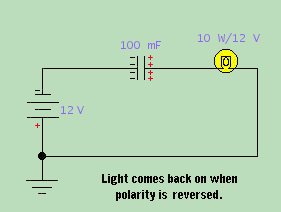 Now if we reverse the polarity of the battery, we see that the same thing happens again, only in reverse. As power is applied, the electrons on the now negativly charged plate of the capacitor will be attracted to the positive side of the battery. As these electrons now leave the plate, it will leave a deficiency of electrons, and the formerly negative plate will become positively charged. At the same time, the electrons from the negative side of the battery will move toward the positively charged plate until the positive plate swings negative. 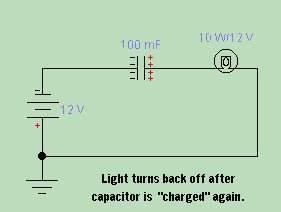
Note that in the examples, the schematic symbol for the capacitor is very similar to that of the battery. There is good reason for this. In a battery, we have 2 (or more) conductive plates divided by some kind of dialectric material (usually an acid). In a capacitor, we have 2 (or more) plates divided by some kind of dialectric material - an insulator. A battery has the ability to generate electricity chemically, and can store energy for long periods of time. While a capacitor does not "generate" electricity, it does have some amazing "storage" capabilities, as we will discuss now. Recall that when we applied power to the capacitor/lamp circuit, electric current flowed for an instant from one side of the battery and lit the lamp for a moment, but then the light went out? What took place, was while the electric current was flowing, a potential was being built up on the surface of the plates of the capacitor. As long as the potential kept building, current continued to flow, and the light remained lit. At some point, however, the capacitor reaches its maximum CAPACITY to hold an electric potential. In other words, it reaches its peak voltage limit, and we say the capacitor is fully charged. If at this time, we were to remove the battery from the circuit, the capacitor, in theory, would remain at full charge indefinately. 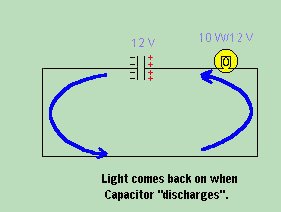
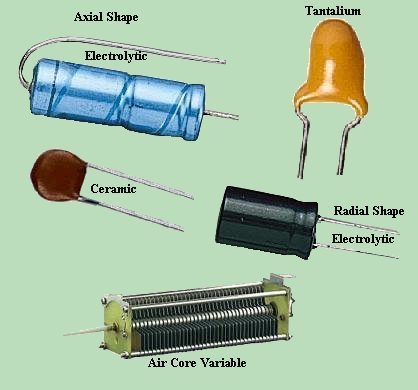 Capacitors come in many shapes and sizes, and each type has its very own special characteristics. To the right is a small example of the variety.
Capacitors come in many shapes and sizes, and each type has its very own special characteristics. To the right is a small example of the variety. The most important values to keep in mind when replacing a capacitor are voltage and capacitance value. Depending on the circuit, it is usually acceptable to use a capacitor of a higher voltage rating that the one being replaced, but the capacitance value must remain the same. Also keep in mind that some capacitors, especially electrolytics, may be polarized positive and negative. If you accidentally reverse the polarity, severe circuit damage, as well as possible injury, may occur. Always pay attention to which way you remove a component from circuit. The symbol for Capacitance is C. The unit of capacitance is the FARAD. The symbol for Farads is F. The Farad is an extremely large quantity, so we typically speak of microfarads ( μf ), nanofarads ( nf ), and picofarads ( pf ). * Note: in some older texts, the term micromicrofarad ( mmf ) is used in lieu of pf. The Capacitance (the amount of energy a capacitor can store) of a capacitor depends on 3 factors:
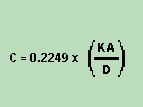 Where C is the capacitance in picofarads, A is the area of one of the plates in square inches, K is the dilectric constant of the insulative material seperating the plates, and D is the distance between the plates. |
| (On The Following Indicator... PURPLE will indicate your current location) | ||||||||||||||||||||||||
| 1 | 2 | 3 | 4 | 5 | 6 | 7 | 8 | 9 | 10 | 11 | 12 | 13 | 14 | 15 | 16 | 17 | 18 | 19 | 20 | 21 | 22 | 23 | 24 | 25 |
| 26 | 27 | 28 | 29 | 30 | 31 | 32 | 33 | 34 | 35 | 36 | 37 | 38 | 39 | 40 | 41 | 42 | 43 | 44 | 45 | 46 | 47 | 48 | 49 | 50 |
| 51 | 52 | 53 | 54 | 55 | 56 | 57 | 58 | 59 | 60 | 61 | 62 | 63 | 64 | 65 | 66 | 67 | 68 | 69 | 70 | 71 | 72 | 73 | 74 | 75 |
| Otherwise - please click to visit an advertiser so they know you saw their ad! |
